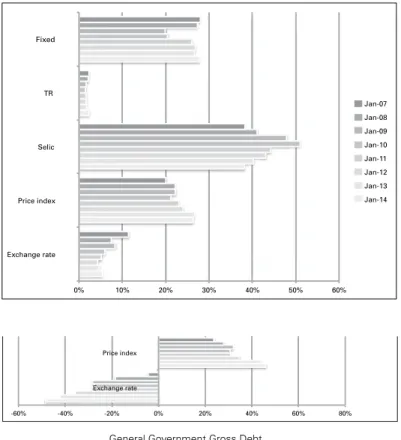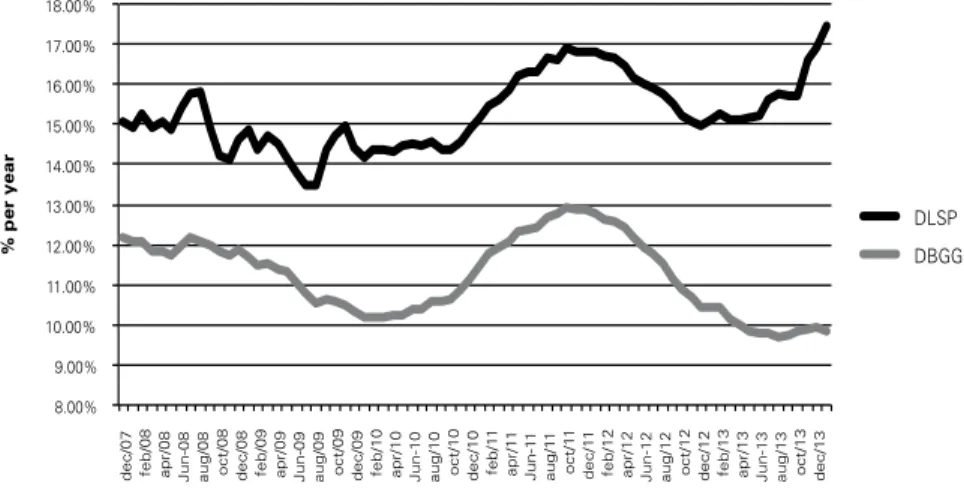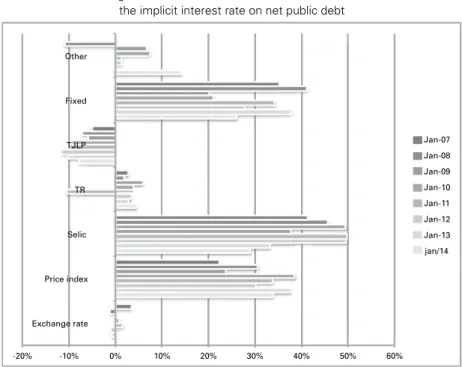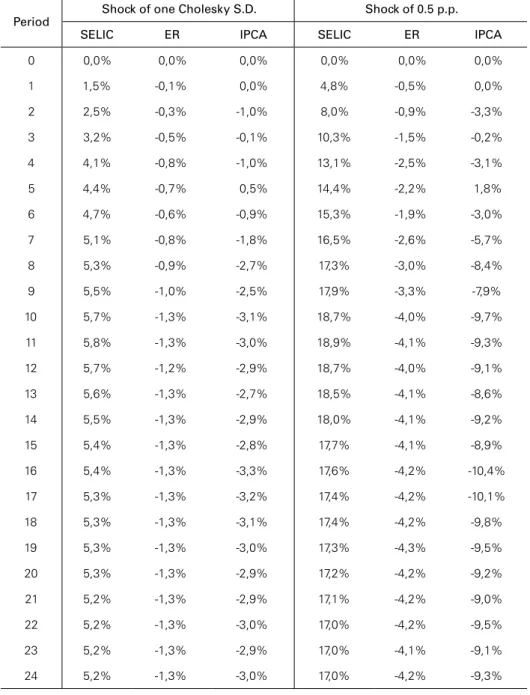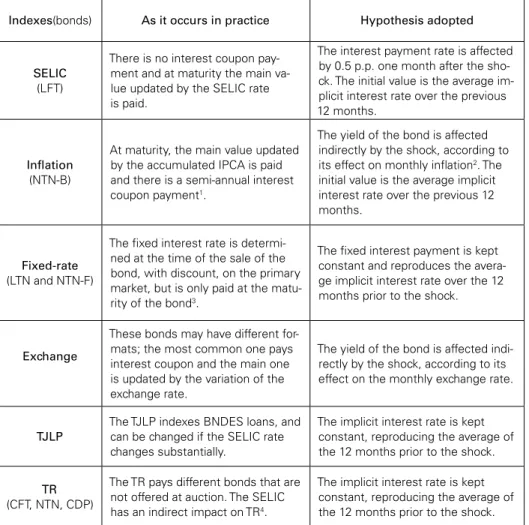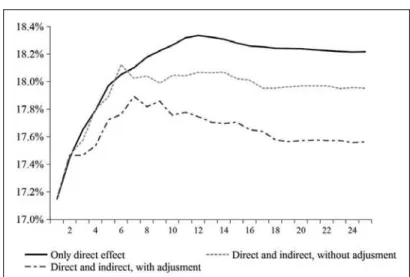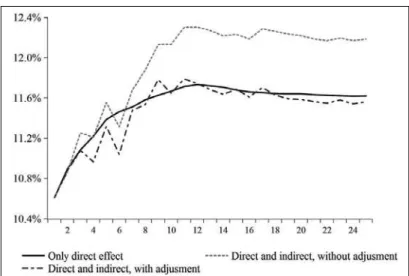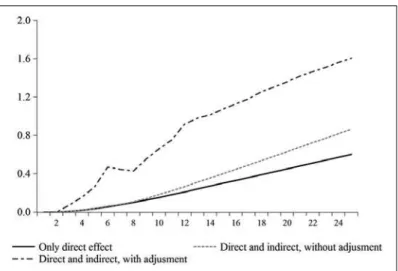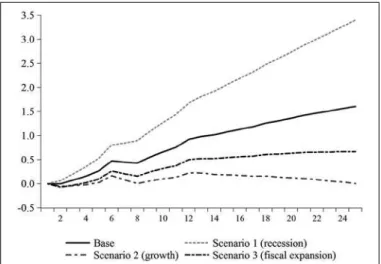Fiscal costs of monetary policy: indirect effects of an
interest rate shock on Brazilian public net debt
Custos iscais da política monetária: os efeitos indiretos de
um choque de juros sobre a dívida líquida do setor público
lAurA CArvAlho André dInIz íTAlo PedroSA Pedro roSSI*
ReSuMO: O artigo estima o custo iscal de um aumento da taxa básica de juros da econo-mia considerando não apenas os efeitos diretos sobre a remuneração dos títulos indexados à SeLIc, mas também os efeitos indiretos que incidem sobre: (i) a remuneração dos títulos públicos indexados ao câmbio e à inlação; e (ii) o estoque da dívida líquida do setor pú-blico, através do ajuste patrimonial das reservas internacionais. As projeções se baseiam na estimação da relação entre taxa básica de juros, taxa de câmbio e inlação a partir de um modelo de vetores autorregressivos. conclui-se que os efeitos indiretos têm impacto indeterminado sobre a taxa de juros implícita da dívida pública quando não se considera o ajuste no valor das reservas internacionais ocasionado pelo impacto da SeLIc na taxa de câmbio. A inclusão desse efeito patrimonial pode ampliicar substancialmente o custo iscal de uma política monetária restritiva, indicando a necessidade de uma maior articulação entre as políticas monetária, iscal e cambial no Brasil.
PALAVRAS-cHAVe: estrutura da dívida pública brasileira; política monetária; nexo juros-câmbio; reservas internacionais; sustentabilidade da dívida
ABSTRAcT: The paper estimates the iscal cost of an increase in the Brazilian policy interest rate – the SeLIc – by considering not only the direct effect on the yield of public bonds that are indexed to the SeLIc, but also indirect effects on: (i) the yield of public bonds that are indexed to the exchange rate and inlation, and (ii) the stock of public net debt through ad-justments in the value of international reserves measured in domestic currency. Projections are based on the estimation of the relationship between interest rates, exchange rates and
*Departamento de economia da universidade de São Paulo. e-mail: decarvalho.laura@gmail.com; escola de economia de São Paulo, da Fundação Getulio Vargas. e-mail andrediniz89@yahoo.com.br: Instituto de economia da universidade estadual de campinas. e-mail: italopedrosa@gmail.com; Instituto de economia da universidade estadual de campinas. e-mail: pedrolrossi@gmail.com. Submitted: 7/April/2015; Approved: 30/July/2015.
inlation by means of a vector auto-regression. We conclude that the inclusion of such indi-rect effects has an ambiguous effect on the response of the implicit interest rate on public net debt to shocks in the SeLIc, when adjustments in the value of international reserves are not considered. However, the inclusion of the latter ampliies the iscal cost of a more restrictive monetary policy. These results call for a better coordination between monetary, iscal and exchange rate policies in Brazil.
KeyWORDS: Brazilian public debt structure; monetary policy; interest rate-exchange rate nexus; international reserves; debt sustainability.
JeL: e43, e52, e63, H63.
INTRODucTION
When compared to the fixed exchange rate regime established in 1994, the adoption of inflation targeting in Brazil in 1999 brought greater flexibility to mon-etary policy and allowed for a reduction in the level of the policy interest rate – the SeLIc. However, as highlighted by Barbosa-Filho (2008), the success of the new regime in controlling inflation has remained tied to the appreciation of the ex-change rate, which kept basic interest rates from reaching international standards. As a very large portion of public bonds in Brazil are indexed to the SeLIc1, the
maintenance of policy rates at a relatively high level has prevented a further reduc-tion in the cost of servicing public debt, which, in turn, requires higher primary surpluses for achieving public debt sustainability.
For directly creating fiscal costs from a monetary policy tightening, the use of the SeLIc as an index for floating-rate public bonds, which initially served the purpose of reducing borrowing costs for the Federal government, has attracted great criticism in the Brazilian economic debate (Bresser-Pereira and Nakano (2002), Bacha (2002)). Indeed, the indexation of floating-rate public bonds to the policy interest rate in Brazil has added a new component to the well-known prob-lems of coordination between fiscal and monetary authorities.
In general, as discussed by Sargent and Wallace (1981), when fiscal policy in-dependently sets its budget and demand for government bonds has an upper limit, the monetary authority might be forced to allow for additional inflation to prevent increases in the real level of public debt. However, the adoption of inflation target-ing with floattarget-ing exchange rates by (semi-) independent central Banks have posed additional challenges in emerging markets, as besides not preventing the risk of fiscal dominance, these regimes can potentially increase the degree of financial in-stability2. For this reason, as argued by Mishkin (2000), the success of inflation
1 In January 2014, 38% of gross debt and 74% of net debt were indexed by the SeLIc. We present a more complete description of Brazilian public debt composition in the subsection “Brazilian Public Debt Structure (page 561).
targeting may still rely on a high degree of coordination between monetary, fiscal and exchange rate policies. The Brazilian singularity in this context is that the in-dexation of public bonds to the SeLIc adds complexity to the puzzle. Indeed, as the central Bank creates a fiscal burden every time it raises the policy rate, the adoption of inflation targeting has often required a contractionary response of fis-cal policy to a tightening in monetary policy as a way to avoid an increase in public debt and the probability of default. While such frequent combination of restrictive monetary and fiscal policies may have generated perverse effects for economic growth, the creation of more fiscal space by a loose monetary policy may have in times turned inflation control more difficult for the central Bank.
Taking advantage of the reduction in Brazilian public debt as a share of GDP in the 2000s and the period of loose monetary policy worldwide following the 2008 crisis, the Brazilian National Treasury has started in 2010 to change its bond issu-ance policy by lengthening the average maturity of public debt and by performing a gradual substitution of bonds indexed to the SeLIc rate – the so-called LFTs – by fixed-rate bonds (LTNs) and bonds indexed to inflation (Secretaria do Tesouro Nacional, 2013). While potentially reducing fiscal costs of monetary policy, as defended by Horta (2011), such a strategy is not consensual, as authors such as Nogueira (2011) see the possibility of increased systemic risk in the complete re-placement of floating-rate by fixed-rate bonds3.
This article aims at contributing to this debate by providing a different perspec-tive on these issues. In addition to the direct effects of the monetary shock on the yield of fixed-rate bonds (LFTs), the article addresses its indirect impacts, i.e., the impact of an interest rate shock on the yield of bonds linked to other indexes, as well as its effect on the value of public sector’s assets and liabilities measured in domestic currency. We aim thus to evaluate, in a broader perspective, the different links between monetary, exchange rate and fiscal policies and four key macroeco-nomic variables in Brazil: the policy interest rate (SeLIc), the inflation rate, the exchange rate and the level of public net debt.
For this purpose, we first analyze the direct and indirect effects of an increase in the SeLIc rate on the yield of floating-rate public bonds that are indexed to the SeLIc itself, the exchange rate and the inflation rate. Second, we show that the accumulation of international reserves by monetary authorities in Brazil in recent years, although necessary for mitigating the impact of international financial cycles in the domestic economy, has turned the value in domestic currency (BRL) of the
with a high level of foreign-currency-denominated debt is more prone to experience a real depreciation and further inflation following an increase in interest rates, due to a higher probability of default.
stock of public net debt very vulnerable to exchange rate fluctuations. In other words, the value of the central Bank’s assets constituting international reserves increases (decreases) with the devaluation (appreciation) of the exchange rate, thus reducing (increasing) public net debt.
To this end, in addition to this introduction, this article has four sections. The second section presents the decomposition of the Brazilian implicit interest rate on public debt in all its indexing factors, as a means to disentangle the evolution in recent years of the share of each debt component, as well as their corresponding yields and maturities. The third section estimates by means of a vector autoregres-sion (VAR) the effects of variations in the policy interest rate on both inflation and the exchange rate, which combined serve as index to a large portion of Brazilian public bonds. The fourth section provides, first, the simulations of the (nominal and real) implicit interest rates on total net public debt following a contraction in monetary policy, based on both the direct and indirect effects of the SeLIc on other indexes and on the value of net debt. Based on such projections, the trajec-tory of the share of public net debt in GDP is simulated for different scenarios. The final section concludes the paper.
DecOMPOSITION OF THe IMPLIcIT INTeReST RATe ON PuBLIc DeBT
data
Most of the data collected for this study were extracted from statistics of pub-lic sector net debt (DSLP) and general government gross debt (DBGG) disclosed by the central Bank of Brazil. While public sector net debt involves the consolidation of liabilities and assets of all non-financial public entities(subtracting assets from liabilities), which includes direct administration, autonomous agencies and the foundations of the three spheres of Government, the central Bank and state-owned firms, general government gross debt includes only liabilities from the Federal government, states and municipalities. Data frequency is monthly and covers the period from December 2006 to January 2014, period for which data are available on the new accounting methodology for general government gross debt4.
The decomposition of public debt and interest payments has been made
cording to six bond indexes: the policy interest rate (SeLIc), the exchange rate, the inflation rate based on three different price indexes (IPcA, IGP-M and IGP-DI), the so-called reference rate (TR), the long-term interest rate (TJLP), which applies to subsidized loans from the Brazilian National Development Bank (BNDeS), and the fixed-rate fraction.
Implicit interest rate on public debt and its decomposition
The implicit interest rate on public debt rt is defined as the ratio between total nominal interest payments in period t, Rt, and total debt in the previous period, Dt-1, according to equation (1):
r R D t t t = −1 (1)
We can decompose the total implicit interest rate as the sum of the product of the implicit interest rate corresponding to each debt component (index) iby the share of such component in total debt in the previous period:
r R D D D t t i t i i t i t = − − −
∑
1 1 1 (2)Based on this decomposition, we can analyze the effect of each component on the implicit interest rate as depending on both its share in total debt and on the trajectory of the corresponding index factor (yield).
In the case of public net debt, public sector’s liabilities are accounted with a positive sign in (2), while public sector’s assets come with a negative sign. Similarly, nominal interest flows received enter with a negative sign and nominal interest paid enters with a positive sign.
Brazilian public debt structure
The balance sheet of the Brazilian public sector has undergone major transfor-mations in the last decade. On the side of public assets, the main changes refer to the accumulation of foreign reserves arising from the exchange rate policy adopted as of 2006. In addition, there was an increase in public assets indexed to the long-term interest rate, due to the transfer of Treasury bonds to BNDeS since 2008. While allowing for countercyclical lending during the crisis5, this policy has relied
on an issuance of bonds indexed to the SeLIc and to other indexes, all of which
require the payment by the Federal government to its bond holders of a higher interest rate than the one charged by BNDeS on its loans (the TJLP), thus creating a fiscal cost at each period of time (Gobetti, 2010).
On the liabilities side, there are two major changes: the reduction in the dollar-denominated foreign debt, and, since 2010, the relative reduction of floating-rate bonds as compensated by a relative increase in fixed-rate and inflation-indexed bonds. As shown in Figure 1(a), the combined share of fixed-rate and inflation-in-dexed bonds rose from 42% of gross debt in January 2010 to 54% in January 2014. Floating-rate bonds went to represent approximately 38% of gross debt in January 2014, as compared to 51% in January 2010. The portion of debt indexed to the exchange rate has been decreasing since 2007 and represents no more than 5.4% of general government gross debt, reflecting the fall in external debt mentioned above. The evolution of the composition of public sector’s net debt, presented in Figure 1(b), indicates an (negative) increase in the share of bonds indexed to the long-term interest rate (TJLP) and to the exchange rate, reflecting the accumulation of foreign reserves and the increase in loans from BNDeS. The TJLP almost tripled its participation as an index of public sector net debt between 2007 and 2014, go-ing from -12% to -39%, as a result of the aforementioned transfers from the Treasury to BNDeS since the 2008 crisis. The exchange rate, in turn, indexes -49% of net debt in January 2014, having considerably increased its relative weight in recent years.
Finally, it is necessary to emphasize the gradual lengthening of federal debt maturities6 (Figure 2), which mainly reflects a decrease in the share of short-term
bonds (up to 12 months) and increase in the share of long-term bonds (over 24 months). Medium-term bonds (between 12 and 24 months) had a slight reduction in the share of total debt. In January 2014, the debt structure was composed by 22% of short-term bills, 18% of medium-term bonds and 60% of long-term bonds, which represent a significant lengthening of maturities when compared to the com-position of 35%, 22% and 43%, respectively, of short-, medium- and long-term securities in January 2007.
The implicit interest rate and the weight of its components
The evolution of the annualized implicit interest rate on both the public sector net debt (DSLP) and the general government gross debt (DBGG) indicates that there have been fluctuations of approximately 11% per year for DBGG and 15% for DLSP in recent years, as shown in Figure 3.
Figure 1: Composition of Brazilian public debt (2007-2013)
0% 10% 20% 30% 40% 50% 60%
Exchange rate Price index Selic TR Fixed
Jan-07
Jan-08
Jan-09
Jan-10
Jan-11
Jan-12
Jan-13
Jan-14
-60% -40% -20% 0% 20% 40% 60% 80%
Exchange rate Price index
General Government Gross Debt Public Sector’s Net Debt
Source: Authors’ elaboration using data from the Central Bank of Brazil (2013)
Figure 2: Maturity profile of Federal Debt Securities
0% 10% 20% 30% 40% 50% 60% 70% 80% 90% 100%
Jan-07 Mar-07 may/07 Jul-07 sep/07 Nov-07 Jan-08 Mar-08 may/08 Jul-08 sep/08 Nov-08 Jan-09 Mar-09 may/09 Jul-09 sep/09 Nov-09 Jan-10 Mar-10 may/10 Jul-10 sep/10 Nov-10 Jan-1
1
Mar-1
1
may/1
1
Jul-1
1
sep/
11
Nov-1
1
Jan-12 Mar-12 may/12 Jul-12 sep/12 Nov-12 Jan-13 Mar-13 may/13 Jul-13 sep/13 Nov-13 Jan-14
Up to 12 months Between 12 and 24 months Above 24 months
The difference between the rate on gross and net debt is explained by the inter-est rate differential between the yield of public assets and liabilities.
Figure 3: Annualized implicit interest rate (12 months moving average)
8.00% 9.00% 10.00% 11.00% 12.00% 13.00% 14.00% 15.00% 16.00% 17.00% 18.00%
dec/07 feb/08 apr/08 Jun-08 aug/08 oct/08 dec/08 feb/09 apr/09 Jun-09 aug/09 oct/09 dec/09 feb/10 apr/10 Jun-10 aug/10 oct/10 dec/10 feb/1
1
apr/
11
Jun-1
1
aug/1
1
oct/1
1
dec/1
1
feb/12 apr/12 Jun-12 aug/12 oct/12 dec/12 feb/13 apr/13 Jun-13 aug/13 oct/13 dec/13
% per year
DLSP DBGG
Source: Authors’ elaboration using data from the Central Bank of Brazil (2013). Note: % per year; DLSP; DBGG; Dec; May; Oct; Mar; Aug; Jan; Jun; Nov; Apr; Sep; Feb; Jul; Dec.
Figure 4 shows the relative contribution of each type of bond in total net interest payments and, therefore, the implicit interest rate. This contribution is given by the share in the payment or receipt of interest flows on net debt (DLSP), as presented in the subsection “Data” on page 560. The figure shows that floating-rate bonds (in-dexed to the SeLIc rate) exert a greater impact on the implicit interest rate on net debt (reaching 50% in January 2012), which is mainly due to its larger share in total debt. However, cuts in the policy rate during 2012 and the relative reduction in the share of SeLIc indexed-bonds have led to a decrease in the corresponding implicit interest rate, thus causing a reduction in their contribution to the total implicit inter-est rate. Inflation-indexed bonds and fixed-rate bonds saw their contributions to the implicit interest rate increase in recent years, mainly due to the new issuance policy.
The portion linked to the long-term interest rate (TJLP), which did not vary greatly throughout this period, had a negative contribution on the implicit interest rate. As mentioned above, the TJLP only indexes public assets, namely all loans from the development bank to business companies. However, this type of operation is usually associated with increased public liabilities that serve as counterpart for the Treasury bond transfers, resulting in a higher implicit interest rate on total public net debt.
impact on the total implicit interest rate when only flows of interest payments and receipts are considered. However, the exchange rate affects not only these flows, but also the value of the accumulated stocks of liabilities and (essentially) public assets in domestic currency, which could change the value of the implicit interest rate on public net debt corresponding to all types of bonds.7 This element is not
captured in Figure 4, but will be explored in the simulations on the fourth section.
Figure 4: Relative contribution of each index to the implicit interest rate on net public debt
-20% -10% 0% 10% 20% 30% 40% 50% 60% Exchange rate
Price index Selic
TR TJLP Fixed Other
Jan-07 Jan-08 Jan-09 Jan-10 Jan-11 Jan-12 Jan-13 jan/14
Source: Authors’ elaboration using data from the Central Bank of Brazil (2013).
ecONOMeTRIc eSTIMATION
The aim of this section is to estimate, through a vector autoregression, the ef-fects of a monetary tightening, triggered by a shock of 0.5 percentage points8 in the
SeLIc rate, on the inflation rate measured by the consumer price index (IPcA) and on the exchange rate. These two variables influence the evolution of the implicit
7 Although the calculation of the implicit interest rate does not explicitly consider a revaluation of assets and liabilities in each period due to exchange rate fluctuations, for the simulation below, we use an expanded concept of implicit interest rate, considering that, in addition to effects on the flows of payments, there is an effect on the stock of debt and the corresponding rates.
interest rate and the public sector net debt, since both function as indexes to public debt and are key determinants of its dynamics. The results presented herein will be used in the fourth section for the simulation of the trajectory of the implicit interest rate and public net debt following a shock in monetary policy.
data
The sample adopted comprises monthly data from January 2003 to December 2013, with a total of 132 observations. The endogenous variables used to capture the indirect effects of the variations in the SeLIc rate in the future trajectory of the two other main indexes of public bonds in Brazil (exchange rate and inflation rate) are: the annualized monthly average SeLIc rate as provided by the central Bank of Brazil; the seasonally adjusted monthly industrial physical production, con-structed by the Brazilian Institute of Geography and Statistics (IBGe); the month-ly average real-dollar exchange rate measured by the central Bank of Brazil; and, finally, the monthly IPcA inflation rate, provided by IBGe, which we seasonally adjusted9 through u.S. Bureau census X12 methodology. As exogenous variables,
all obtained through Bloomberg, we used the cDS-Brazil as a proxy for sovereign risk; the overnight rate of the Federal Reserve of the uSA (Fed Funds); and the Standard & Poors GScI (SPGScI) commodity price index.
responses of inlation and exchange rates to shocks in the interest rate
In order to allow for the interpretation of our estimation results as elasticities of response to shocks in the interest rate, all variables have been transformed into logarithms for the econometric study10.
To check for the presence of unit roots, we performed augmented Dickey– Fuller (ADF) (Dickey and Fuller, 1981) and Phillips and Perron (PP) (Phillips and Perron, 1988) tests11, including only intercept, and intercept plus trend. The same
tests were carried out for all series in first differences so as to verify the order of integration of the series that have a unit root.
For the exchange rate, the SeLIc policy rate, the industrial production index, commodity prices (SPGScI) and the Fed Funds rate (FF), all tests for the series in level did not reject the null hypothesis of a unit root with 5% confidence, which have allowed us to treat the series as non-stationary. All tests for the inflation rate (IPcA) and cDS rejected the null hypothesis of unit root, also with 5% confidence. As there is no evidence of the presence of a unit root for all series, cointegration
9 For seasonal adjustment, we use IPcA monthly inflation data since January 1998.
tests were not performed, as they require that all variables are integrated of the same order. Alternatively, we have studied the joint behavior of these variables in a vector autoregression model using variables in first differences12.
The endogenous vector yt consists of the first difference of the variables SELIC, IPCA, ER, and IP, all in logarithms, where IPCA stands for the inflation rate, ER is the Brazilian Real (BRL) – uS dollar (uSD) exchange rate, and IP is the indus-trial production index, with the latter used as a proxy for economic activity. The choice of variables was very similar to that of Luporini (2008).
In order to control for some of the external effects on the Brazilian economy, we added a few exogenous variables. The literature has found that commodity prices, as measured by the SPGScI index, influence the determination of the ex-change rate, the inflation rate and industrial production. The Fed Funds rate, in turn, was used as a proxy for the level of the foreign interest rate, and can influence all endogenous variables of the system, as well as the Brazilian Sovereign risk, as represented by the 5-year cDS (cDS5y).
The selection of the lag structure was performed considering the baseline rec-ommendations of Schwarz (VAR (1)) and Akaike (VAR (10)) information criteria, as well as the LR (VAR (8)) sequential likelihood ratio. To select the order of the VAR model, we considered the trade-off between parsimony and robustness, as-sessed in terms of residual behavior. Models including one to five lags have shown serial correlation. The estimation of a VAR(6) has shown no heteroskedasticity and no serial autocorrelation based on an LM test. Finally, as in other studies focusing on the transmission channels of monetary policy such as Minella (2003) and Luporini (2008), residuals have not been found to be normal.
As widely known in the literature, a crucial part of estimating impulse-response function is the identification of the reduced-form VAR to get the structural equations. After selecting the order of the vector autoregression with all variables in first
dif-ferences, we have generated cumulative impulse response functions for a cholesky one standard deviation shock in the SeLIc policy rate. The ordering adopted is similar to the ones verified in christiano et al. (1999), Minella (2003), Dedola and Lippi (2005) and Tomazzia and Meurer (2009): industrial production, inflation rate, SeLIc and exchange rate. The rationale for the ordering is that the proxy for the output (industrial production) does not contemporaneously respond to the other variables (and rather affects them) because the level of production is decided before the production takes place; the price level (or in our model the inflation rate) may be affected contemporaneously by current demand and production, while under normal circumstances the exchange rate and the SeLIc only affect it after a time
lapse; the SeLIc rate for instance is decided on a regular basis and the central bank has good indicators for assessing the current level of production and prices and then set the base interest rate; and finally the exchange rate is a high-frequency data that is potentially affected contemporaneously by all the information set.
Figure 5: Accumulated Responses to a shock of one Cholesky standard deviation ± 2 S.D.
Source: Authors’ elaboration.
After a certain time lapse, an increase in the policy rate is expected to generate an appreciation of the exchange rate, a reduction in industrial activity (and eco-nomic activity) and a reduction in inflation. Figure 5presents the impulse response functions to a one cholesky standard deviation in d ln (SELIC), all of which show the expected signs13, namely a negative overall response of industrial production,
the exchange rate and the inflation rate over a two-year period. The appreciation of the exchange rate is instantaneous and persists over time. The inflation rate measured by the IPcA index reaches its lowest value after 8-10 months, and re-mains at a lower level.
Table 1: Variation of the inflation rate and the exchange rate following a shock in the policy rate
Period
Shock of one Cholesky S.D. Shock of 0.5 p.p.
SELIC ER IPCA SELIC ER IPCA
0 0,0% 0,0% 0,0% 0,0% 0,0% 0,0%
1 1,5% -0,1% 0,0% 4,8% -0,5% 0,0%
2 2,5% -0,3% -1,0% 8,0% -0,9% -3,3%
3 3,2% -0,5% -0,1% 10,3% -1,5% -0,2%
4 4,1% -0,8% -1,0% 13,1% -2,5% -3,1%
5 4,4% -0,7% 0,5% 14,4% -2,2% 1,8%
6 4,7% -0,6% -0,9% 15,3% -1,9% -3,0%
7 5,1% -0,8% -1,8% 16,5% -2,6% -5,7%
8 5,3% -0,9% -2,7% 17,3% -3,0% -8,4%
9 5,5% -1,0% -2,5% 17,9% -3,3% -7,9%
10 5,7% -1,3% -3,1% 18,7% -4,0% -9,7%
11 5,8% -1,3% -3,0% 18,9% -4,1% -9,3%
12 5,7% -1,2% -2,9% 18,7% -4,0% -9,1%
13 5,6% -1,3% -2,7% 18,5% -4,1% -8,6%
14 5,5% -1,3% -2,9% 18,0% -4,1% -9,2%
15 5,4% -1,3% -2,8% 17,7% -4,1% -8,9%
16 5,4% -1,3% -3,3% 17,6% -4,2% -10,4%
17 5,3% -1,3% -3,2% 17,4% -4,2% -10,1%
18 5,3% -1,3% -3,1% 17,4% -4,2% -9,8%
19 5,3% -1,3% -3,0% 17,3% -4,3% -9,5%
20 5,3% -1,3% -2,9% 17,2% -4,2% -9,2%
21 5,2% -1,3% -2,9% 17,1% -4,2% -9,0%
22 5,2% -1,3% -3,0% 17,0% -4,2% -9,5%
23 5,2% -1,3% -2,9% 17,0% -4,1% -9,1%
24 5,2% -1,3% -3,0% 17,0% -4,2% -9,3%
Source: Authors’ elaboration.
Based on the impulse response functions to a standard deviation shock in d ln (SELIC), we have obtained, for a given initial value, the responses to a shock of 0.5 percentage points in the SeLIc by transforming results accordingly. In other words, for each level of the SeLIc rate there is a certain shock in first differences that cor-responds to a change of 0.5 percentage points in the actual rate. Starting from a SeLIc rate of 10%, which prevailed by the end of December 2013, the magnitude of the shock in first differences that is equivalent to a 0.5 percentage points increase in the SeLIc rate is 0.04879.
This transformation has allowed us to evaluate the indirect effects of an in-crease of 0.5 in the SeLIc rate on the yield of other public bonds and the trajec-tory of public net debt. In particular, in order to simulate the trajectrajec-tory of the infla-tion rate and the exchange rate following the shock, we have calculated the change in their levels over 24 months and applied these changes to their initial values.
Table 1 shows the magnitudes used for projecting the indirect effects of a shock in the policy rate on the IPcA inflation rate and the BRL-uSD exchange rate, as well as on the SeLIc rate itself. In other words, results have shown that an initial increase in the SeLIc rate is followed by a cycle of monetary tightening. Hence, the effects we study can be understood as triggered by an initial shock in the SeLIc rate, but encompass a whole cycle of monetary tightening. All accumulated chang-es were applied to the initial valuchang-es prevailing in the month of the shock. After 24 months, according to the estimates carried out, our estimates indicate that the monetary tightening triggered by a 0.5 p.p. shock in the policy rate results in a reduction of 9.3% on the inflation rate and a 4.2% appreciation of the Brazilian Real against the dollar.
SIMuLATIONS
Simulation of the implicit interest rate on public net debt
The projection of the implicit interest rate on public net debt following a shock in the policy interest rate has proven to be a complex task. The complication arises from the existence of a wide variety of public bonds in the market, when we consider not only their nature (fixed-rate, floating-rate, etc.), but also the different maturities.
even the direct effect of increasing the SeLIc rate on the floating-rate portion of public debt is difficult to assess, since the interest payments on these bonds occur only at the time of their maturity. In practice, as an ex-post variable, the interest rate effectively paid by the government is not automatically affected by the increase in the SeLIc. This increase is gradually incorporated as the floating-rate bonds liquidation occurs. In addition, this impact is more diluted, the greater the matu-rity of the bonds, since it is only by the liquidation of the floating-rate bonds, the holder receives the interest rate accumulated over the period.
our study has established a few simplifying hypotheses associated with the impact of the interest rate shock on the yield of public bonds, and thus on the correspond-ing implicit interest rates. The main hypotheses are that: (i) the implicit interest rate of the floating-rate portion immediately absorbs the shock; (ii) the implicit interest rate corresponding to the inflation-indexed fraction suffers the indirect impact of the higher SeLIc on the inflation rate immediately, and (iii) the fixed-rate portion does not suffer the effect of the interest rate shock. In general, these hypotheses overestimate the effect of the variation in the different indexes on the corresponding implicit interest rates, which yields an ambiguous net effect on the total rate. On the one hand, the positive effect of the interest rate shock on the implicit interest rate corresponding to the floating-rate fraction of debt is overstated. On the other hand, the negative effect on the implicit interest rate corresponding to the inflation-indexed portion is also overestimated, as highlighted in Table 2.
Table 2: Yield of public assets and liabilities and hypotheses of the simulations
Indexes(bonds) As it occurs in practice Hypothesis adopted
SELIC
(LFT)
There is no interest coupon pay-ment and at maturity the main va-lue updated by the SELIC rate is paid.
The interest payment rate is affected by 0.5 p.p. one month after the sho-ck. The initial value is the average im-plicit interest rate over the previous 12 months.
Inflation
(NTN-B)
At maturity, the main value updated by the accumulated IPCA is paid and there is a semi-annual interest coupon payment1.
The yield of the bond is affected indirectly by the shock, according to its effect on monthly inflation2. The
initial value is the average implicit interest rate over the previous 12 months.
Fixed-rate
(LTN and NTN-F)
The fixed interest rate is determi-ned at the time of the sale of the bond, with discount, on the primary market, but is only paid at the matu-rity of the bond3.
The fixed interest payment is kept constant and reproduces the avera-ge implicit interest rate over the 12 months prior to the shock.
Exchange
These bonds may have different for-mats; the most common one pays interest coupon and the main one is updated by the variation of the exchange rate.
The yield of the bond is affected indi-rectly by the shock, according to its effect on the monthly exchange rate.
TJLP
The TJLP indexes BNDES loans, and can be changed if the SELIC rate changes substantially.
The implicit interest rate is kept constant, reproducing the average of the 12 months prior to the shock.
TR
(CFT, NTN, CDP)
The TR pays different bonds that are not offered at auction. The SELIC has an indirect impact on TR4.
The implicit interest rate is kept constant, reproducing the average of the 12 months prior to the shock.
This simplification does not affect the main conclusions of the study, namely that a restrictive monetary policy still has significant fiscal costs, due to two impor-tant effects: the indirect effects of the shock in the policy rate on other public bond indexes (exchange rate and inflation), and the impact of monetary policy on the value of public sector’s assets in domestic currency (through an increased cost of carrying foreign reserves).
Figure 614 shows the simulation results for the implicit interest rate on net
public debt after an increase of 0.5 percentage points in the SeLIc rate, assuming the simplifying hypotheses presented in Table 2. The initial increase in the policy rate endogenously generates further increases in the SeLIc afterwards, so that the shock can be interpreted as the beginning of a monetary tightening cycle: as can be seen in Table 1, the policy rate achieves a peak after 11 months, being 18,8% higher than before the shock.
The impact is measured in three different ways, all of which assumed away any changes in the composition of debt. For this end, we took as reference the debt structure prevailing in December 2013 and the average implicit interest rate of each debt component over the 12 months prior to the month of reference.
Figure 6: Evolution of the nominal implicit interest rate on public net debt after a shock of 0.5 p.p. in the policy rate
Source: Authors’ elaboration.
The first simulation only measures the direct effect of the interest rate shock, namely, the impact of the increase in the SeLIc rate on the floating-rate fraction
of the stock of bonds. We can note a permanent increase in the implicit interest rate as, ceteris paribus, the floating fraction incorporates the interest rate increase.
The second simulation incorporates the indirect effects of the policy shock, which essentially focus on the yield of the inflation-indexed bonds. The inclusion of the indirect effect reduces the nominal implicit interest rate in comparison with the first simulation. This reduction can be explained by the impact of the increase in the interest rate on the inflation rate, which reduces the payment of interest on inflation-indexed bonds.
Figure 7: Evolution of the real implicit interest rate on public net debt after a shock of 0.5 p.p. in the policy rate
Source: Authors’ elaboration.
Finally, the third simulation measures the total effect of the monetary tighten-ing cycle by also incorporattighten-ing the adjustment in the value of public sector’s assets in domestic currency, as caused by the appreciation of the exchange rate. The ap-preciation of the exchange rate has the effect of increasing public net debt, as it devalues the stock of foreign reserves in national currency. This effect on the value of net debt does not change the net amount of interest paid, which is the numerator in the calculation of the implicit interest rate, but, by increasing the denominator, it relatively reduces the implicit interest rate. Hence, with the inclusion of the variation in asset values, our results reinforce the ambiguous nature of the impact of a monetary policy shock on the nominal implicit interest rate on net public debt in the short-run, as this effect goes in the opposite direction of the increase in inter-est paid on the floating-rate portion15.
Moreover, the idea that the indirect effect on inflation positively contributes to the government fiscal stance (as it relatively reduces nominal implicit rates) is also misleading, as highlighted by the trajectory of the real implicit interest rate shown in Figure 7. With the inclusion of the indirect effect, which reduces the rate of inflation, the same nominal interest payment results in a greater real implicit interest rate. In other words, the effect of the reduction in inflation, on the one hand, reduces the nominal payment of interest of the inflation-indexed bonds (as com-pared to the case in which only direct effects takes place), and on the other hand, increases the real implicit interest rate. For this reason, the two simulated real im-plicit interest rates considering indirect effects (with or without variation in asset values) are greater than the real implicit interest rate that considers only the direct effect of the policy shock. As will be seen in the following subsection, the real im-plicit interest rate is the one relevant for the evolution of public debt.
The trajectory of net public debt
Given the trajectory for the implicit interest rate on net public debt presented in the previous subsection, it is possible to assess the evolution of the stock of net public debt from the law of motion represented in equation (3).
D Y
t
t
= +
+
+
1
1
1
( rr D s V Y
i t i t t t
t i
I , ). , − + + =
∑
1 1
(3)
where D stands for the stock of net debt, Y is GDP, r is the real implicit inter-est rate (subtracting the inflation rate from the nominal implicit interinter-est rate), s is the primary surplus and V is the change in the value of net debt arising from asset revaluations.
Besides starting from the law of motion in (3), projections have maintained all the previous assumptions regarding the composition of public debt and the behav-ior of implicit interest rates corresponding to each bond index i. Simulations based on (3) required additional assumptions for the annual GDP growth rate (2.3%) and the primary surplus as a percentage of GDP (2.0%)16.
We present the projections for net debt as a share of GDP following a 0.5 p. p. shock in the policy rate as deviations from the scenario we call ‘unchanged mon-etary policy’. Of course, the values for the baseline scenario follow the same law of motion represented in (3). In other words, we keep the same assumptions for GDP growth and the primary surplus, but we also keep the implicit interest rates
constant through time.
bonds. The pricing of such bonds, as that of any financial asset, depends on the capitalization of an expected income flow based on a reference discount rate. Hence, given the increase in the SeLIc, we can expect that newly issued fixed-rate bonds will offer a higher yield.
Figure 8 shows the trajectory of the debt-to-GDP ratio for each of the previous scenarios – including only the direct effect on floating-rate bonds, also including indirect effects on exchange rate and inflation-indexed bonds, and incorporating asset revaluation effects – in the aftermath of the monetary tightening.
The figure highlights both a significant increase in public net debt to GDP and the substantial difference in the evolution of net debt when the revaluation of pub-lic net assets is considered. In 24 months, the monetary tightening triggered by the 0.5 p.p. shock in SeLIc rate causes a 1.6 p.p. increase in public sector net debt as a share of GDP, more than the 0.6 p.p. observed in the case when only the impact on floating-rate bonds is considered. This difference can be explained once again by the currency appreciation caused by the shock.
When it comes to the inclusion of indirect effects, the reduction in the inflation rate and the corresponding increase in the real implicit interest rate leads to a rela-tive increase in the debt-to-GDP ratio when compared to the first scenario.
Figure 8: Evolution of the public debt-to-GDP ratio as deviation of ‘unchanged monetary policy’ case following a shock of 0.5 p.p. in the policy rate (in p.p.)
Source: Author’s elaboration.
evolution of net public debt based on different scenarios for GDP growth and the primary surplus
Table 3: Scenarios for projection of the debt-to-GDP ratio
Scenarios ∆ GDP (%) Primary surplus
(%GDP)
Base 2.3 2.0
Scenario 1 (recession) 0 2.0
Scenario 2 (growth) 4.5 2.0
Scenario 3 (fiscal expansion and growth) 5 1.5
Source: Authors’ elaboration.
Scenario 1 is one of economic stagnation, which could be a result of the inter-est rate shock itself, and shows a considerable increase of the debt-to-GDP ratio. Two years after the shock, the share of net debt in GDP is 5.6 p.p. higher than its initial value (33.4%).
Figure 9: Evolution of the public debt-to-GDP ratio as deviation of ‘unchanged monetary policy’ case following a shock of 0.5 p.p. in the policy rate for different scenarios
Source: Authors’ elaboration.
Scenario 2 maintains the same primary surplus but considers an optimistic scenario for economic growth (4%). The combination of this scenario with the interest rate shock keeps net debt stable, thus offsetting the impact of the monetary tightening. In other words, given the base scenario (in which GDP growth is 2.3%), an increase of 2.2 p.p. in the annual GDP growth rate is needed to partially offset the monetary tightening if the government wants to keep the debt-to-GDP ratio stable.
of the primary surplus from 2.0% to 1.5% of GDP, there is need for an even higher rate of economic growth in order to keep debt sustainability.
cONcLuSION
The debate on the fiscal costs of monetary policy in Brazil has traditionally attributed to the role of floating-rate bonds the main responsibility for burdening the government fiscal stance whenever the central Bank raised the policy rate. The present article has sought to deepen this discussion by incorporating the analysis of indirect effects of variations in the policy interest rate on other public bond in-dexes, namely the exchange rate and the inflation rate, as well as the impact of this effect on the valuation of foreign reserves in domestic currency.
When it comes to nominal interest flows, the inclusion of such indirect effects seems to mitigate fiscal costs of monetary policy when compared to the case where only the impact on floating-rate bonds that are indexed to the policy interest rate are considered. This difference arises especially through the impact on inflation, which relatively reduces nominal interest payments on the fraction of inflation-indexed bonds. However, when it comes to the stock of net debt, an increase in the debt burden is caused by the negative effect of the currency appreciation on the value of public sector’s foreign assets measured in domestic currency.
Given the simplifying hypotheses of the model, our simulations show that, after two years, a monetary policy tightening triggered by a positive shock of 0.5 percentage points in the policy rate causes an increase of 1.6 p.p. on public net debt as a ratio to GDP. Further, the projected response of the debt-to-GDP ratio to the monetary tightening based on different scenarios for GDP growth and the primary surplus reinforce these conclusions, as even in the most optimistic scenario, GDP growth does not fully compensate the perverse effects of monetary tightening on the level of debt.
It is important to point out that we have only considered scenarios based on a constant structure of public debt. In recent years, the composition of Brazilian public debt has changed significantly towards a de-indexation of bonds from the policy interest rate and a higher issuance of fixed-rate and inflation-indexed bonds. Our results suggest that in the short term, without considering variations in asset values, the recent increase in price indexation is indeed mitigating the direct impact of monetary policy on the implicit interest rate on public debt. The same applies to the increase in the fixed-rate fraction of total debt, even if that will take more time to play a role, as fixed-rate bond payments are mostly realized in the medium or long run. However, by also taking into account revaluations in foreign reserves, one can argue that the recent changes in the issuance policy of the Brazilian National Treasury are not substantially diminishing the fiscal costs that arise from a mone-tary contraction.
exchange rate channel, even if these costs have also been reduced by recent chang-es in the bond issuance policy. Rather than calling for a slower accumulation of foreign reserves, which remains important for mitigating the country’s vulnerabil-ity to international liquidvulnerabil-ity cycles, the evidence presented in this study adds an-other piece to the well-known trade-offs involved in the adoption of inflation tar-geting when there is need for policy coordination.
While on the one hand, adding a permanent concern over public debt sustain-ability to the execution of monetary policy does not seem compatible with its mandate keeping inflation on target; on the other hand, requiring the primary surplus to instantaneously vary in response to changes in the policy interest rate (and the exchange rate) as a way to stabilize the level of public net debt may add pro-cyclical features to the implementation of fiscal policy, with potentially perverse effects for economic growth and/or inflation control. Hence, the complex set of interactions between policy tools and goals examined in this paper seem to call for an intermediate configuration, with some degree of coordination between fiscal, monetary and exchange rate policies over longer periods of time.
ReFeReNceS
Alves, L. F., Silva, A. c. (2009) “Planejamento estratégico da dívida pública federal in: Silva, A. c., car-valho, L. O., Medeiros, O. L. (Orgs.), Dívida Pública: A Experiência Brasileira, Secretaria do Te-souro Nacional/Banco Mundial, Brasília, pp. 149-171.
Arida, P. and Resende, A. L. (1985) “Inertial inlation and monetary reform in Brazil”. Working Paper
No 85, Department of economics Puc-Rio.
Bacha, e., (2002) “comentários a ‘uma estratégia de desenvolvimento com estabilidade’”. Available at: http://www.bresserpereira.org.br/view.asp?cod=1807.
Barbosa-Filho, N. (2008) “Inlation targeting in Brazil: 1999-2006. International Review of Applied
Economics 22:2, 187-200.
Blanchard, Olivier. (2004) “Fiscal dominance and inlation targeting: lessons from Brazil”. NBER
Working Paper No. 10389.
Bresser-Pereira, L. c., Nakano, y., (2002) “uma estratégia de desenvolvimento com estabilidade”.
Re-vista de Economia Política 22:3, 146-180.
christiano, L. J., eichenbaum, M. and evans, c. (1999) “Monetary policy shocks: what have we lear-ned and to what end?” In: Handbook of Macroeconomics, elsevier Science/North Holland. Dedola, L. & Lippi, F. (2005). “The monetary transmission mechanism: evidence from the industries of
ive OecD countries”. European Economic Review 49, 1543–1569.
Dickey, D. A., Fuller, W. A., (1981) “Likelihood ratio statistics for autoregressive time series with a unit root”. Econometrica 49: 4, 1057-1072.
Gobetti, S. W. (2010) Dívida líquida e dívida bruta: o efeito da estrutura patrimonial sobre a taxa de
juros implícita e a trajetória do endividamento, Tesouro Nacional, Brasília.
Horta, G. T. L. (2011) Administração da dívida pública: um estudo para o caso brasileiro, Tesouro Nacional, Brasília.
Luporini, V. (2008) “The monetary transmission mechanism in Brazil: evidence from a VAR analysis”.
Estudos Econômicos 38: 1, 7-30.
Minella, A., (2003) “Monetary policy and inlation in Brazil (1975-2000): a VAR estimation”. Revista
Mishkin, Frederic S. (2000) “Inlation targeting in emerging-market countries”. American Economic
Review 90:2, 105-109.
Nogueira, F.c., (2011) “câmbio, juros e inlação: tateio”. Textos Avulsos n. 8, Observatório da econo-mia Global Ie/uNIcAMP.
Pereira, T. R., Simões, A, carvalhal, A., (2011) “Mensurando o resultado iscal dos empréstimos do Tesouro ao BNDeS: custo ou ganho líquido esperado para a união”. Texto para Discussão 1665, IPeA.
Phillips, P., Perron, P., (1988) “Testing for a unit root in time series regression”. Biometrika, 75: 2, 335-46.
Sargent, Thomas J. and Wallace, Neil. (1981) “Some unpleasant monetarist arithmetic”. Federal
Reser-ve Bank of Minneapolis Quarterly Review 5, 1-17.
Secretaria do Tesouro Nacional (2013) Dívida pública federal: plano anual de inanciamento 2013. Ministério da Fazenda, Secretaria do Tesouro Nacional, Brasília.
Securato, J.R. (2002) Cálculo Financeiro das Tesourarias, Saint Paul editora, São Paulo.
Tavares, R., Tavares, M.F. (2009) “Títulos públicos federais e suas formas de preciicação”. In: Silva, A. c., carvalho, L. O., Medeiros, O. L. (Orgs.), Dívida Pública: A Experiência Brasileira, Secretaria do Tesouro Nacional/Banco Mundial, Brasília, pp. 307-337.
